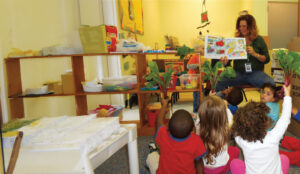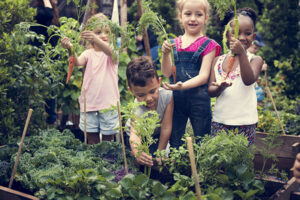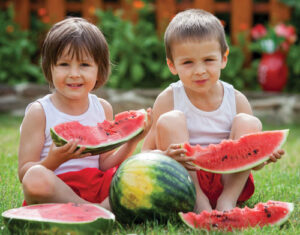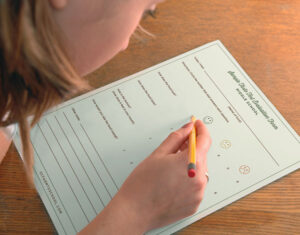The garden is not meant to take away from time learning, it is meant to be incorporated into everyday learning activities and lessons!
The garden does not have to be in full bloom before it can be used as a tool for learning. Providing some early learning experiences will help stimulate children’s thinking about gardening, and it is a great way for teachers to assess children’s current knowledge and interest. By understanding what children already know about a topic, experiences can be planned that not only extend current knowledge, but generate excitement! You are not limited to only doing garden activities outside. By bringing the garden indoors, it can be a resource for curriculum and daily activities.
Integrating the Garden into Child Care & Preschool Settings
The garden is a great learning tool for children and tying it into daily activities can help address many of South Carolina’s Early Learning Standards. Encourage children to help with all phases of the garden, whether it is the development, planning, harvesting or maintenance. Below are some examples of activities and tasks that meet South Carolina’s Early Learning Standards:
- When planting in the garden, children can assist with measurement of how far apart and how deep to plant seeds and seedlings (M-K-5)
- Working as a team within your center to help maintain your garden allows children to learn how to interact with others and express their feelings appropriately (SE-K-4)
- Designating roles and responsibilities for each child to have in the garden will help them develop and appreciate their own abilities and accomplishments (SE-K-1)
Each of the experiences described address several standards outlined in the document titled Good Start Grow Smart Standards: South Carolina’s Early Learning Standards for 3, 4, & 5 Year-Old Children.

Ask questions about the content of the story (e.g., “What do you think will happen next?” “What would happen if…”). Some book suggestions:
- Growing Vegetable Soup by Lois Elhert
- Planting a Rainbow by Lois Elhert
- Eating the Alphabet by Lois Elhert
- How a Seed Grows by Helene J. Jordan
- The Tiny Seed by Eric Carle
- The Vegetables We Eat by Gail Gibbons
- I Heard It from Alice Zucchini by Juanita Havill
- The Curious Garden by Peter Brown
- The Carrot Seed by Ruth Krauss
Include Non-Fiction and Informational Books About Fruits, Vegetables, Flowers and Gardening in the Classroom Library, Dramatic Play Experiences and Writing Center
Choose books with colorful photographs; they do not have to be specifically written for children. Discuss the photos and text with the children, encouraging them to draw, write and talk about the information in the book.
Examples of Good Start Grow Smart Standards addressed:
- ELA-3K-1.1: Explore realistic books and materials in classroom centers.
- ELA-4K-2.4: Incorporate information from informational texts into play activities.
- ELA-K-6.2: Recognize that information can be found in print sources (e.g., books and pictures)
This could include:
- Artificial fruits, vegetables and flowers
- Flower pots, gardening spades and watering cans
- Gardening gloves, aprons and sun hats
- Potting Soil (optional)
- Empty seed packets
- Paper and pencils so children can make lists, labels, signs, etc
Examples of Good Start Grow Smart Standards Addressed:
- AL-3K-4.2: Organize actions and materials needed for play in the learning environment.
- AL-4K-1.1: Show creativity and imagination when using materials in representational play.
- AL-K-3.2: Demonstrate initiative in planning, creating and carrying out activities.
- M-K-1.6: Use a variety of forms of mathematical communication.
Include questions like, “Do you have a garden? If yes, what kind; in-ground garden, raised-bed garden, or container garden”, “What grows in your garden?”, “What kinds of vegetables do you like to eat at home?” and “How do you prepare them?”. The children could also be invited to help develop the survey, including questions they would like to ask their family members. When surveys are returned, discuss the results with the children. Make charts and/or graphs to share the results. (e.g., How many children have gardens at home? How many families eat carrots at home? How many families have flowers growing in their yard?). Post these charts for families to see and discuss with their child.
Examples of Good Start Grow Smart Standards addressed:
- ELA-3K-4.8: Participate in small group reflections on a recent event.
- ELA-4K-4.1: Describe events of personal significance.
- AL-K-2.2: Demonstrate eagerness and interest as a learner by questioning and adding ideas.
Take a walk outside and talk about all the different kinds of plants that the children see. Identify the leaves, stalks, trunks, blooms, etc. When finished, provide children with blank paper and crayons and tell them to draw something they saw on the plant hunt. Ask the children to describe their drawings, writing their words on their drawing.
Examples of Good Start Grow Smart Standards Addressed:
- ELA-3K-4.8: Participate in small group reflections on a recent event.
- ELA-4K-4.3: Creates a picture and labels it orally.
- PD-K-2.3: Use drawing and writing tools with some control and purpose.
When Engaging in Various Experiences Related to Your Garden, Be Sure to Ask Children a Lot of Questions and Give Them The Opportunity to Talk About What They See, Know and Wonder About
Use children’s discussions and answers to questions to help select books and materials about gardening. This information will be helpful in planning meaningful experiences to extend their knowledge and to support conversations with them while working in the garden. Listening to children will not only help the caregiver decide what experiences will be most meaningful to them, but will help the caregiver know what the children love to do! Examples of questions that could be asked include:
- What kinds of vegetables do you like to eat?
- What kinds of fruits do you like to eat?
- Where do fruits and vegetables come from?
- Why are plants important?
- What can you do with plants?
- How do you plant a seed?
- What do you think plants need to grow?
- What do you think you need to do to take care of a garden?
Examples of Good Start Grow Smart Standards addressed:
- AL-3K-5.1: Talk about prior events and personal experiences.
- AL-4K-5.4: Demonstrate growing ability to predict possible outcomes based on prior experiences and knowledge.
- ELA-K-4.2: Generate complete sentences orally.

When presenting new items for children to try, it is important to focus on the sensory experience before expecting them to eat a new food. The exploration of the produce can help spark interest and curiosity, in turn increasing the chances of children trying a new food.
- Starting off with a mystery bag/box, place a produce item inside. Have children use their sense of touch to explore if the item is smooth, rough, hard, soft, etc. and if possible, have an option with the item cut so children can also feel the interior. Ask them to describe it.
- Remove the item from the box and ask the class if they have ever seen the item before. Talk about the exterior of the item and if possible, the interior. If it is something that comes in a variety of colors, talk about the different options. Ask them if they have ever eaten that item and if so, how was it prepared?
- Ask the children to draw the item using various drawing tools.
- Ask the children what the first letter of the item is and to think of other fruits and vegetables that start with that letter. Have children write down their words or do it on a white board as a group. Write down the adjectives that are used to describe the item as well.
- Wrap up by reminding the children that eating fruits and vegetables makes us healthy and strong because they have lots of vitamins that help us grow!
Examples of Good Start Grow Smart Standards addressed:
- ELA-5: The child will begin to write for a variety of purposes and audiences.
- ELA-6.3: The child will begin to access and use information from a variety of sources – classifying information
- PD2: Fine Motor Control: Children use their fingers and hands in ways that develop hand to eye coordination, strength, control and small object manipulation.
Plan a taste test of the vegetables that will be planted in your garden. A taste test is an activity that introduces children to foods and beverages they may not have tried before. A taste test can be conducted during snack time or mealtime or as a stand-alone activity in the classroom. See Suggestions for a Successful Taste Test below.
Let families know in advance there will be a taste test so the center can be made aware of any allergies or sensitivities their child may have. After the taste test, help each child complete an “Eat Smart…It’s a Matter of Taste I Tried It” Card. Send this card home to let families know the foods they tried at the center. This card can be found at the end of this section.
Conduct a poll about which vegetables children liked most and liked the least. Create a picture graph with the children to share the results. For example, on a piece of poster board, create columns with photos of the crops the children tasted across the top. Have children draw a check mark under what they liked. Total the check marks in each column to reveal their favorites!
Suggestions for Successful Taste Tests
- Prepare To Grow. Involve the children and all their senses in exploring the fruit or vegetable. Children are more likely to try a food that they have explored.
- Sow Seeds of Success. Children will be more willing to try a food if they know it is okay to remove something they do not like rather than swallow. Never force a child to eat a food. Model how to politely decline to taste a food or use a napkin to remove the food from the mouth.
- Seed and Re-seed. Plan to offer the food many different times. Studies show some children need to be offered a food up to five times before they will taste it. In addition, the food may need to be offered more than a dozen times before a child will choose to eat it at a meal. Do not give up – some seeds take longer to grow than others.
- Start in Fertile Ground. Offer new foods first to children willing to try new things. Watching a peer eat a food can help the most reluctant eater bud into a food taster.
- Be Still, Little Seed. For safety’s sake, have the children eat while seated, not walking around. Moving while eating can increase the risk of choking.
- Offer Bites, Not Bushels. Offer small tastes of a food at first. A child can be overwhelmed by a large portion and may even refuse to try a food, fearing it must be finished. Portions need to be small enough for small mouths and large enough so a child has to chew the food. It is safer to have a piece that cannot be swallowed whole. Be prepared to offer more if a child desires to taste again.
- Know the Growing Season. Fresh fruits and vegetables in season usually taste best and are less expensive. Use your harvest finder, SC Produce Availability Chart or Palmetto Picks to choose from what is in season. In South Carolina, produce is available year round!
(Source: Eat Smart Move More Grow Healthy Toolkit, Department of Health and Environmental Control, 2012. Adapted from “Growing Great Tasters: Strategies for Food Tasting”, Grow It, Try It, Like It! Preschool Fun with Fruits and Vegetables; US Department of Agriculture’s Team Nutrition)
Integrating the Garden into School Settings
The school garden is a fun addition that is not meant to take away time from learning, but rather to be used as a tool in the learning process. As mentioned in Chapter 1, one of the benefits of the garden is academic growth among students. When the garden is incorporated into the classroom, students are given a new set of learning opportunities. There are many demands placed on teachers and students for meeting academic standards; address these standards in a setting naturally fit for exploration and discovery. This section of chapter 7 provides examples for incorporating the garden into main academic disciplines of grades kindergarten through twelfth.
The easiest fit most teachers see for incorporating the garden into a classroom subject is with science. The scientific method is a perfect fit for all grade levels, whether it is making observations, forming a hypothesis or designing an experiment. Below are some more suggestions for activities from different science disciplines that are a great fit with the garden:
All levels of math skills can be used in the garden! Math can be part of the garden from the beginning when planning the size of the garden to the end when measuring and weighing the produce that is harvested. Below are some more suggestions for incorporating math skills:
- Measure the growth rates of plants, display results on different types of graphs and make predictions regarding future growth
- Tally cricket chirps to estimate temperature
- Use graph paper to make a map to scale of your garden
- Calculate amounts of fertilizer to use per quart and per liter of water
- Chart temperatures of the air and soil in your garden in Fahrenheit and Celsius
- Determine the weight and volume of soil mix when wet and dry
- Determine the volume of soil in a rectangular window box
- Measure the height of a group of plants and determine the mean, median and mode
- Make a recipe that uses fruits and vegetables from the garden and requires various measuring techniques
Concepts from history and social studies can be built into gardening activities. There is a rich and diverse history of farming and agriculture across many cultures and this is an opportunity to link gardening activities with history lessons. Working in the garden is also a natural way to develop social skills for the students to learn how to work together. See the suggestions below for more ideas about incorporating social studies in the garden:
- Study the contribution of Native American foods and other cultures’ foods to our history and diet; grow samples in the school garden
- Trace the steps of a fruit or vegetable from the field to the table
- Research and report on cultural or ethnic differences in food and gardening practices
- Research agricultural history and create a timeline of important events
- Visit some local farms and interview farmers about the choice of crops, growing practices, marketing and farm history
- Contact, report on or volunteer services at a local food bank, gleaning project or food cooperative
- As a class, develop garden rules and then vote on them
- Interview experienced community members, local farmers or senior citizens about their gardening/farming experiences
- Research and report on how other cultures use and control insects
Reading and writing are important skills to have in our everyday lives. Writing journal entries about experiences in the garden is a great way for children of all ages to strengthen their writing skills. Comprehension skills can be enhanced when reading information related to the planning, harvesting and maintenance of the garden. There are many books available, ranging from children’s picture books to extension guides, that are a great way to practice reading skills. Below are some more suggestions:
- Keep daily garden journals documenting observations, weather conditions and classroom activities
- Study and learn how to use seed catalogs
- Write and compile a class gardening book with gardening skills and advice
- Read the daily newspaper and bring in any articles related to gardening, food, farming, nutrition, hunger, etc.
- Research the growing habits of the school garden plants using the Internet and reference material
- Write letters to local merchants explaining the school gardening program and asking for donations
- Write thank you notes to volunteers and garden sponsors
- Brainstorm different adjectives to describe each plant in your garden
- Study new vocabulary that relates to plants and gardens
- Publish a class newsletter with student articles about the garden and distribute it to other classrooms and parents
- Write step-by-step instructions for common garden activities
- Read books and stories about plants and gardens
- Prepare and deliver a presentation about the garden for other students, teachers and parents
The garden is a great site for arts and crafts. Many aspects of the garden, whether it is a garden bed, pots or garden markers can be decorated as part of an art lesson. Do not forget you can even use parts of the garden and harvest for craft activities as well. Here are some more ideas:
- Design labels to mark plants
- Paint rocks to use as garden borders
- Create paintings and drawings of garden plants
- Paint a class garden mural to hang in the hallway for parents’ night
- Make a seed mosaic
- Create a color wheel collage using pictures from old seed catalogs
- Make prints using paint and stamps made from various plant parts
- Draw your dream garden
- Paint a classroom mural using samples of different soils as the medium
- Design labels for plants to mark plantings
- Design T-shirts for your garden
- Design a logo for your garden
- Put together a photo essay of the garden
Whether it is singing garden songs or making musical instruments from the garden, there are a number of ways to bring music and drama class to the garden:
- Make musical instruments from gourds
- Create and perform a garden-inspired dance expressing the growth of a seed or the opening of a flower bud
- Pantomime various gardening tasks (e. g., transplanting, fertilizing, sowing seeds, pollinating)
- Learn a collection of songs that relate to food, gardens and the environment
- Create a skit about food safety
- Use a movie camera with single-frame capability to make a time-lapse film of a plant growing
- Write parodies of well-known songs, turning them into gardening songs
- Hold a harvest festival square dance
- Take a garden-themed piece of children’s literature and do reader’s theater with it
Aside from all of the delicious produce that can be sampled from the garden, the garden is a great tool for health and nutrition lessons. When sampling produce from the garden, incorporate it into a classroom taste test or do a cooking demonstration. Here are some more ideas for combining the garden with health and nutrition lessons:
- Conduct a blindfolded taste test using classroom-grown vegetables and supermarket vegetables
- Experiment with food preservation techniques (e.g., drying, freezing and canning)
- Visit a local farm
- Keep food journals that highlight how many fruits and vegetables are eaten and describe any new produce tried
- Invite chefs from the community to do cooking demonstrations for students and parents with garden produce if available
- Coordinate a cooking lesson in your school’s kitchen using the produce your class has grown
- Ask cafeteria managers to share safe food handling information and provide tours of school kitchens
- Create a classroom or school recipe book that features produce grown in the garden
- Compare the nutritional content of different colors of a specific variety of vegetables grown
- Visit a local farmers’ market or start a school farmers’ market
- Grow and use fresh herbs to flavor your dishes with natural ingredients and decrease the use of salt in recipes
- Create a school announcement promoting fruits and vegetables in season each month





